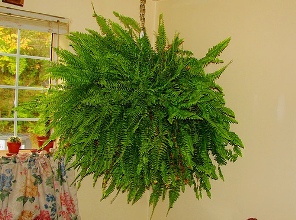 Boston Fern Picture courtesy Jim KlockeThe Boston fern is native to tropical regions throughout the world. It must be the most popular indoor fern, with its long hanging fronds of plain or frilly leaves. Many people use Boston ferns outdoors to adorn their decks and porches during the warm summer month. They grow beautifully in humid locations that receive plenty of indirect sunlight, but in cold, frosty regions they must be brought indoors in autumn if they are to survive. Boston ferns are a wonderful addition to the home; adding an elegant charm and classic beauty unlike any other houseplant.
Boston Fern Picture courtesy Jim KlockeThe Boston fern is native to tropical regions throughout the world. It must be the most popular indoor fern, with its long hanging fronds of plain or frilly leaves. Many people use Boston ferns outdoors to adorn their decks and porches during the warm summer month. They grow beautifully in humid locations that receive plenty of indirect sunlight, but in cold, frosty regions they must be brought indoors in autumn if they are to survive. Boston ferns are a wonderful addition to the home; adding an elegant charm and classic beauty unlike any other houseplant.
Boston ferns like a warm (not hot) position indoors with good light but no direct sunshine. Keep them away from cold draughts. They will flourish indoors if their specific requirements are met, but when those requirements aren't met, they slowly dry up and gradually shed their leaves.
Humidity is essential to Boston ferns, so they must receive an adequate amount of water to flourish. An average home does not provide the amount of humidity required, especially in cold winter regions when the home is heated. Fifty percent humidity is ideal. To provide your fern with some of the humidity it requires, mist spray the leaves daily with tepid (not cold) water (rainwater or filtered water is best). Placing a standing fern on a drip tray filled with pebbles and a little water also helps to create humidity. As the water evaporates, humidity is naturally provided to the plant. For excellent results, purchase a humidifier for the room. This is a great investment since it provides countless benefits to the home and family as well as to moisture loving plants.
In summer, keep the soil evenly moist but not saturated; never allowing the soil to dry out totally. In winter, allow the surface of the soil to become a little dry before watering. When the new fronds appear at the end of winter; start watering more often. During spring, summer, and autumn feed your fern every two weeks with a water soluble, high nitrogen houseplant food like Nitrosol, that is diluted to half of the recommended strength. Do not feed during the winter months.
It is not necessary to re-pot a Boston Fern until the roots entirely fill the pot. Do this by dividing the plant into a few large clumps by cutting through the roots with a sharp knife. Do not divide them into very small pieces or the plants will take too long to recover and grow. To make a potting mixture suitable for Boston ferns, combine 2 parts peat moss, 2 parts sterile potting soil, 1 part perlite and a handful of charcoal granules.


